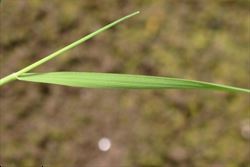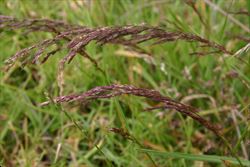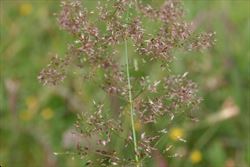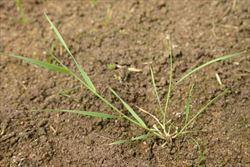Click on images to enlarge

infestation (Photo: Trevor James)

stem and leaves (Photo: Trevor James)

close-up of very elongated leaf blade (Photo: Trevor James)

close-up of stem and base of leaf blade showing the tiny membranous ligule (Photo: Trevor James)

young seed-heads (Photo: Trevor James)

seed-head in flower (Photo: Trevor James)

close-up of tiny flower spikelets (Photo: Trevor James)

young plant (Photo: Trevor James)
Scientific Name
Agrostis capillaris L.
Synonyms
Agrostis capillaris L. var. aristata (Parn.) DruceAgrostis capillaris L. var. capillarisAgrostis tenuis Sibth.Agrostis tenuis Sibth. var. tenuisAgrostis tenuis Sibth. var. aristata (Parn.) DruceAgrostis vulgaris With.Agrostis vulgaris With. var. aristata Parn.
Family
Gramineae (South Australia)Poaceae (Queensland, New South Wales, the ACT, Victoria, Tasmania, Western Australia and the Northern Territory)
Common Names
brown top bent grass, browntop, brown-top bent, browntop bent, brown-top grass, colonial bent grass, colonial bentgrass, common bent, common bent grass, New Zealand bent grass, Prince Edward Island bent grass, Rhode Island bent, Rhode Island bent grass
Origin
Native to northern Africa (i.e. Tunisia), the Canary Islands, Europe and parts of western and central Asia (i.e. Turkey, northern Iran, Afghanistan, Armenia, Azerbaijan, Georgia, Kazakhstan and southern Russia).
Naturalised Distribution
Widely naturalised in the wetter parts of southern Australia (i.e. in eastern New South Wales, the ACT, Victoria, Tasmania, south-eastern South Australia and the coastal districts of south-western Western Australia). Also widely naturalised in other parts of the world.
Notes
Brown-top bent (Agrostis capillaris) is a significant environmental weed in Victoria and an environmental weed in New South Wales, South Australia, Western Australia and Tasmania. This species has been widely grown as a turf grass in the cooler parts of Australia and is now a major weed of disturbed sites and pasture in this part of the country. However, it also invades dry coastal vegetation, heathlands and heathy woodlands, lowland grasslands and grassy woodlands, dry sclerophyll forests, damp sclerophyll forests, riparian vegetation, freshwater wetlands, and alpine and sub-alpine vegetation. The vigorous growth of this exotic perennial grass enables it to compete strongly with, or in some places even displace, native species.
Brown-top bent (Agrostis capillaris) is regarded as a very serious threat to one or more vegetation formations in Victoria. It is particularly troublesome in wetlands and riparian areas, and is regarded as a high threat weed species in remnant floodplain riparian woodlands in some parts of the state. This species appears on numerous local and regional environmental weed lists, particularly in the wetter parts of the state (e.g. in Monash City, Knox City, Monash City, Manningham City, Banyule City, Hepburn Shire and the Goulburn Broken Catchment). It is also present in many conservation areas, including Morwell National Park, Brisbane Ranges National Park, Phillip Island Nature Park and Yarra Bend Park.
Competition from brown-top bent (Agrostis capillaris), and other introduced grasses, is thought to pose a threat to the endangered plump swamp wallaby-grass (Amphibromus pithogastrus) in Victoria, through direct competition and also by reducing bare areas for potential establishment of seedlings. It is also likely to compete with the vulnerable small milkwort (Comesperma polygaloides) in remnant grasslands on the basalt plains of western Victoria.
This species is also of significant concern in the cooler parts of New South Wales. It is listed as an environmental weed in the wider Sydney and Blue Mountains region and is one of the "exotic perennial grasses" invading native plant communities in New South Wales which are regarded as a "key threatening process". In particular, brown-top bent (Agrostis capillaris) aggressively competes with native species in bog and fen communities (i.e. montane peatlands and swamps). It is common in disturbed areas in the sub-alpine and alpine areas of Kosciuszko National Park, in southern New South Wales, and is particularly persistent in these areas, even in the absence of continued disturbance.
In South Australia, brown-top bent (Agrostis capillaris) is currently treated with less concern, though it is known to invade damp bushland areas. It has also been recorded in several conservation areas in the south-eastern parts of this state (i.e. Mark Oliphant Conservation Park, Kaiserstuhl Conservation Park, Belair National Park and Kyeema Conservation Park).
Note: recent research suggests that much of what is called brown-top bent (Agrostis capillaris) in south-eastern Australia is actually highland bent (Agrostis castellana). If so, then it could be by far the most aggressive and invasive bentgrass (Agrostis sp.) in Australia.

